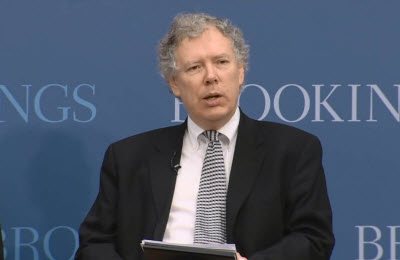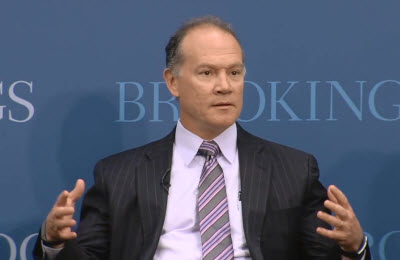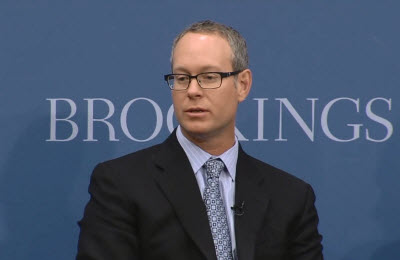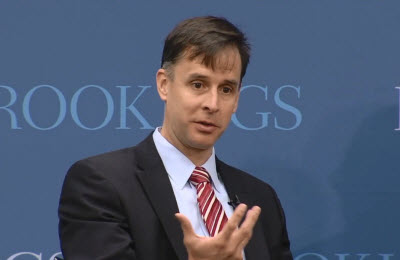On May 2, the Center for Technology Innovation (CTI) at Brookings hosted a panel of industry experts to address the future of digital content delivery in the United States, including discussion on how the explosion of video streaming is changing how we consume content. Below are some highlights from the discussion. Archived video is available on the event’s page, and TechTank blog will have a more detailed analysis of the event soon.
 Darrell West, vice president and director of Governance Studies and founding director of CTI, and who moderated the discussion, observed that:
Darrell West, vice president and director of Governance Studies and founding director of CTI, and who moderated the discussion, observed that:
We all know that today is a time of great change in telecommunications. There are new digital platforms that have emerged that stream videos and voice over the Internet and deliver content via tablets and smartphones. These systems have expanded the multiplatform mix for communications, entertainment and commerce. And at the same time, an Internet of Things based on sensors and machine-to-machine communication offers the potential to forge new relationships between customers and businesses.
West is author of a new paper released at the event: “Video Streaming and Content Delivery.” In it, West argues that “government officials need to promote innovation that maximizes the benefits of new developments. We need to make sure that vulnerable populations are able to reap the benefits of the technology revolution.”
Panelists included John Donovan, AT&T’s senior executive vice president for technology and network operations; Derek Aberle, president of Qualcomm, Inc.; and Jeremy Legg, a senior vice president at Turner Broadcasting System.
 Donovan said that the new environment of networking and technology is “challenging in every dimension: the people, the way we manage the business and then the underlying technology that we’ve built.” He noted that the growth of mobile is up “about 50,000 percent on our network,” plus “video is exploding as the primary use of the network.” Globally, he said, video is over 50 percent of network consumption.
Donovan said that the new environment of networking and technology is “challenging in every dimension: the people, the way we manage the business and then the underlying technology that we’ve built.” He noted that the growth of mobile is up “about 50,000 percent on our network,” plus “video is exploding as the primary use of the network.” Globally, he said, video is over 50 percent of network consumption.
Donovan also pointed to the “Internet of things” as a “very different kind of network,” a network of “small, chatty packets running up and down.” That combined with what he called “big sticky bits of video” and “we have been forced to fundamentally rethink technology that delivers it.”
Finally, he said, people have to change, too. AT&T is a 136-year-old company employing over 250,000 people. “We now have to go back and retool a workforce … to go to things in this new environment,” Donovan said.
 Aberle also spoke to the “tremendous change in the industry over the last ten years.” From mobile devices that have increased computing power, data speeds and ability to do video well, “all of these trends are coming together at the same time,” he said. He called it “an explosion in data traffic” and now “you’re seeing this expand out into new verticals like automotive and health care [and] the Internet of things.”
Aberle also spoke to the “tremendous change in the industry over the last ten years.” From mobile devices that have increased computing power, data speeds and ability to do video well, “all of these trends are coming together at the same time,” he said. He called it “an explosion in data traffic” and now “you’re seeing this expand out into new verticals like automotive and health care [and] the Internet of things.”
“In addition to needing more spectrum to satisfy all this demand,” Aberle said, “there’s a lot of innovation left ahead in terms of driving new technology on the network side. … Those are the technologies that I think we’ll need to complement what has been done on the mobile innovation really to drive the network forward as we move ahead.”
 Legg asked, “what isn’t changing in content distribution at this point?” He observed that in his own company, Turner Broadcasting System, “We were a content creation company that’s migrating to becoming a company that’s also a software company” as well as a distribution company.
Legg asked, “what isn’t changing in content distribution at this point?” He observed that in his own company, Turner Broadcasting System, “We were a content creation company that’s migrating to becoming a company that’s also a software company” as well as a distribution company.
For consumers, he explained:
the number of choices that they have as to where they want to watch and how they want to watch is simply expanding more and more. We are simulcasting our television feeds on iPhones, on Androids devices, through Xboxes, through other connected devices that aren’t just set-top boxes as we’ve traditionally done over the history of the television industry.
“We’ve essentially created a parallel universe,” Legg said.
We distribute our video through the managed video network in the last mile historically. Now we’re distributing essentially that same set of content through the broadband pipe over the last mile as well. For the consumer at the end of the day, they don’t really care about the distinctions between the two things. However the devices that render that content do care about the distinction between those things. So you are ending up with a software layer on the devices that renders the video, whether it’s coming from the managed video network or it’s coming from the broadband network, that we now have to be very attuned to because it impacts advertising and measurement and content delivery in ways that it didn’t use to.
Toward the end of the program, an audience member asked the panelists what they see coming on five- and 10-year horizons. West also asked each panelist what he is most worried about.
Legg described a new product, CNNx, that allows viewers to annotate videos in real time to get all of the content from around the web about that content, and also to go to the social conversation on Facebook or Twitter about that content. “That’s an example of how we’re going to have to think in the future,” he said. While this might be one future for news and sports, Legg added that in entertainment, “consumers want to watch great programming.”
“I don’t know that the technology changes great storytelling,” Legg said. Which was the subject of the thing that he said worries TBS the most: “finding enough great storytellers”:
Creating hit programming is like drilling for oil. You get a lot of dry wells before you ultimately get a show that is a hit. It’s hard to make a Game of Thrones … not only to secure the rights for it but to find the creative talent to tell stories like that. You can’t bottle it and resell that kind of stuff. There are very few people that are able to do that. And the playing field in terms of who can now distribute content and who can make networks available is larger than it’s ever been. It’s not four broadcast networks; it’s not four broadcast networks plus a couple hundred cable networks. The ability for people to tell stories and deliver those via the Internet or other platforms is becoming unlimited. And we’re going to have to make sure our voice remains relevant now and well into the future to make sure people want to watch our programming.
Aberle said that the place he sees innovation in the future is mobile health care. “I can’t see any other platform to deliver what we need to deliver across the globe in terms of improving health care,” he said, “so I think there will just be a tremendous amount of investment and innovation that goes into that space over the next five years.”
Yet Aberle expressed his worry, which is the U.S. remaining competitive globally. “We’re investing 20 percent of our revenue every year in R&D,” he said, adding that “we can only do that and satisfy our shareholders as long as they believe that there’s a return to those investments. And it’s very, very competitive when you are trying to take your technology around the world … where a lot of the growth is going to come from.”
Donovan’s answer to the future horizon question centered on the possibilities of the Internet of Things, “my things coordinating with each other.”
I don’t go want to look at the weather to figure out if I should to take an umbrella. I want my umbrella connected to the web and I want it to glow a color on the way out the door so that I don’t have to think about it. I want my dryer to coordinate with the power company and be energy efficient on its own. I want my schedule to determine, to coordinate with my car so I don’t have to type in navigation. So the removal of steps is my five-year horizon. That’s my dream in life.
My ten-year vision is I’d like to see the software developers get together with the deep scientists and I would like … the collective knowledge to be put into apps that are real time that would allow us to take most of the impediments we are born with and level the playing field. Nobody should be mathematically impaired, because you should have onboard capabilities to deal with math. You shouldn’t be language impaired. You should have those things on your fingertips. And so ten years now I actually believe that you are going to be able to take most of the things that you are not good at and be good at it.
Donovan’s worry, as he explained it, is that he doesn’t want the web to be curated:
With all of the complexity simplification comes, and with simplification a curator arrives. And I don’t want a curator. I don’t want the web curated. It’s fascinating and you laugh for a little while, and you get these things that figure you out and then all of a sudden everything I’m looking at is presented in a relevant fashion, and then I say, where’s the quirky stuff? Where’s the stuff that makes me different from me? And then you don’t stretch. I worry about that. In my dream world, the five-year and 10-year horizons are beautiful places but there are some bumps in the road and I think one of them is complexity curated equals a narrowing and I’m back to being taught something.
Get more research and commentary on mobile and broadband technology from the Center for Technology Innovation.


Commentary
How Three Telecomm Leaders See the Future of Mobile, Video, Content Delivery, and the Internet of Things
May 2, 2014